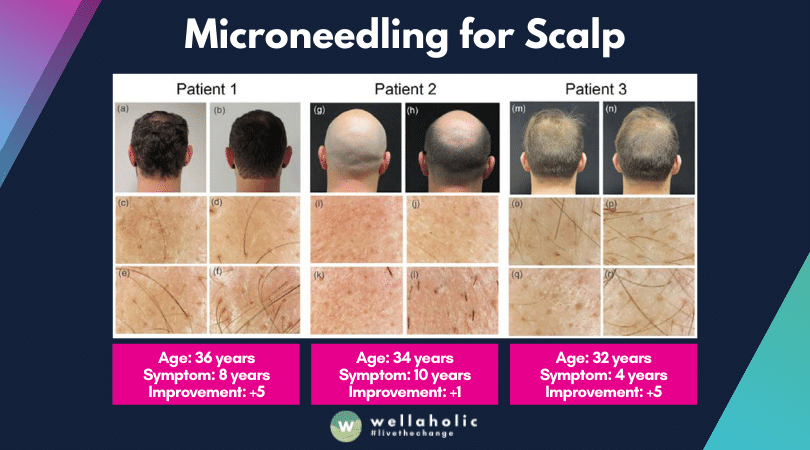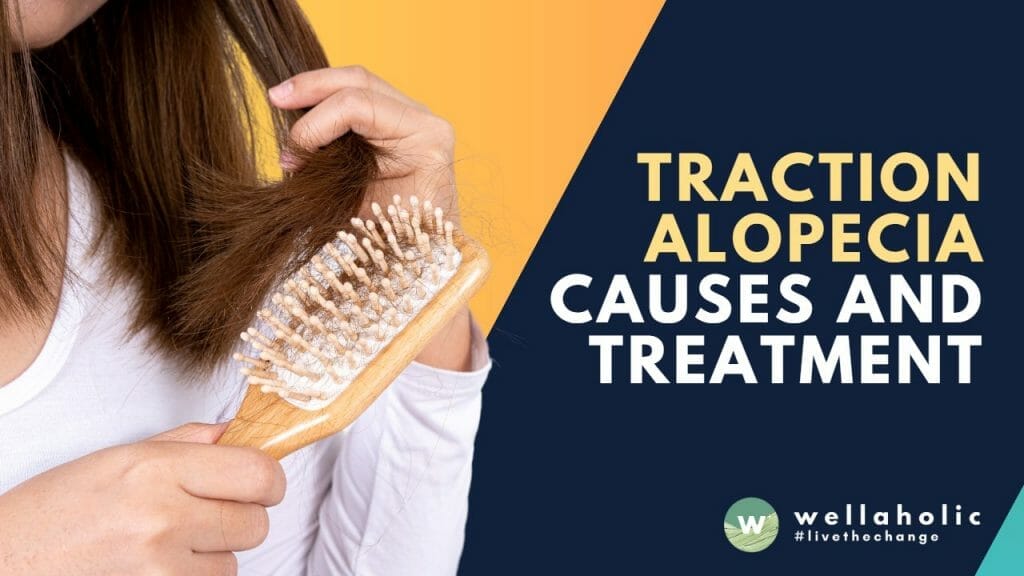
A Complete Guide to Preventing and Treating Traction Alopecia

🚨 Preventing & Treating Traction Alopecia
Your Guide to Healthy Hair Practices
📊 Key Facts
⚠️ Common Causes
💡 Prevention Tips
🩺 Treatment Options
Advanced: Hair transplant, growth factor therapy
Recovery: 6-12 months for maximum regrowth
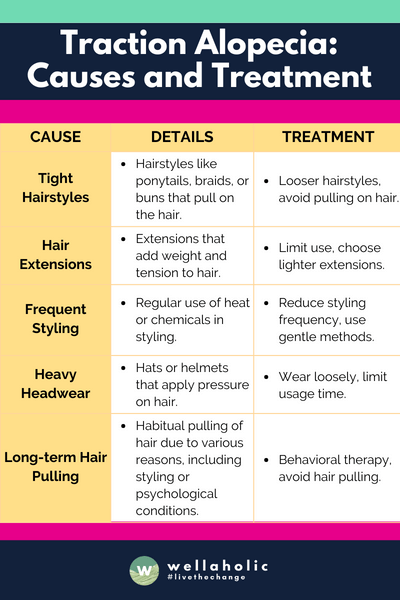
Introduction to Traction Alopecia
Have you ever wondered if your favourite hairstyle could be causing hair loss?
Traction alopecia is a form of hair loss that occurs when constant pulling forces are applied to the hair, often due to tight hairstyles or hair accessories. As aesthetic professionals at Wellaholic, we’ve seen firsthand how this condition can affect our customers. From tight ponytails and braids to heavy extensions and chemical treatments, various factors can contribute to traction alopecia.
In this article, we’ll explore the causes of this condition and discuss effective treatment options to help you maintain a healthy scalp and luscious locks.
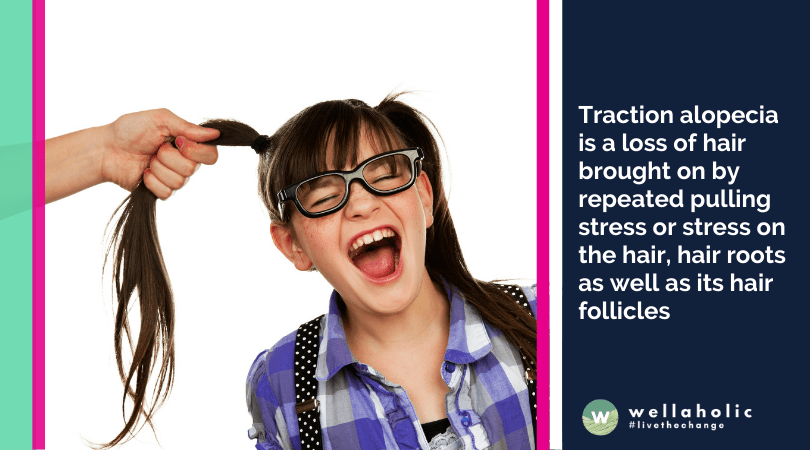
What is Traction Alopecia?
Have you ever wondered if your favourite hairstyle could be causing hair loss? Traction alopecia is a type of hair loss that occurs when constant pulling force is applied to the hair over time. At Wellaholic, we often see customers concerned about thinning hair along their hairline or temples. This condition is typically caused by tight hairstyles that put excessive tension on the hair follicles.
Traction alopecia can affect anyone who frequently wears tight hairstyles, but it’s particularly common among women who regularly use braids, tight ponytails, or hair extensions. We’ve noticed it’s especially prevalent in our customers with African-textured hair, as certain protective styles can inadvertently cause damage if worn too tightly or for extended periods. The good news is that if caught early, traction alopecia is often reversible. However, if the pulling continues for too long, it can lead to permanent hair loss as the follicles become damaged beyond repair.
Traction alopecia can occur at any age, but it is most common in women between the ages of 15 and 35, based on a study compiled by Wellaholic.
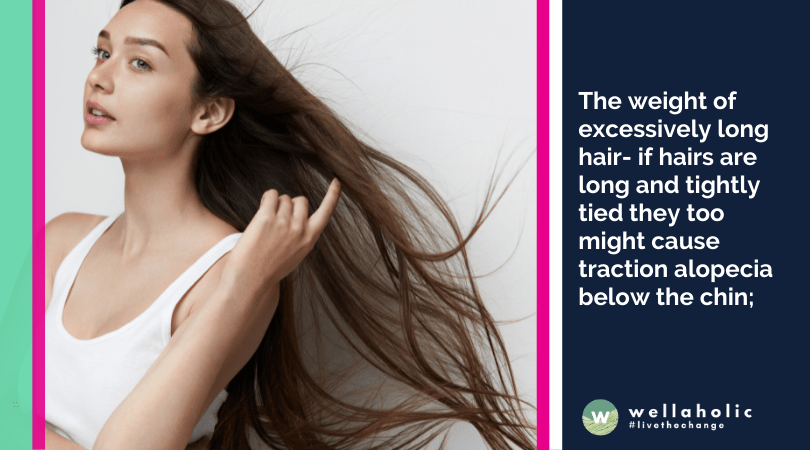
What are the causes of Traction Alopecia?
Not every lady can to these beauty salon horror tales certainly, however that doesn’t imply they are risk-free from traction alopecia. This kind of hair loss is frequently self-inflicted as well as may be triggered by:
- Tight braids, weaves, chignons, ponytails, dreadlocks, and other scalp-pulling hairstyles which is common in Asian hairstyles
- The weight of excessively long hair- if hairs are long and tightly tied they too might cause traction alopecia below the chin;
- Hair extensions- especially if they are tightly tied or glued to the base of your hair
- Chemical treatments such as hair relaxers- they may alter the structure and chemical composition of the hair strands and follicles, thus leading to hair loss
- Hair Rollers – especially if the hair is put up in rollers overnight for different types of hair
- Wearing hair accessories, e.g., hair grips or slides the same way every day
- Headwear, e.g., helmets and tight elastic bands
Essentially what these hairstyling procedures do is produce traction. When this occurs repetitively, as well as for a long term duration, inflammation creates around the hair origin, as well as the hair shaft ends up being loosened in its roots. Ultimately, the hair might wind up falling out in clumps, which can lead to adverse effects and psychological effects to your well-being.

What are the signs that you are suffering from Traction Alopecia?
Hair loss is often slow. We might not see the damage from hair loss right away. But, signs can show traction alopecia. These signs include:
- Short, broken hairs near your hairline or where your hair gets pulled a lot.
- Your hairline going back, especially at the temples or neck.
- Your scalp might be red, sore, itchy, or have little pimples.
At first, traction alopecia doesn’t scar. But, if we keep pulling our hair, scars and red skin can appear. Then, hair gets thin and less dense. These symptoms are different for everyone.
How we treat our hair can cause this problem. It often affects the sides and front of the scalp. This is known as the fringe sign. It’s a clear sign of this hair loss type.
Can Traction Alopecia be reversed?
Traction alopecia is a condition I often see in my practice. It happens when hairstyles pull on your hair too much. This can hurt your hair roots. If you spot it early, you can usually fix it. The first signs are often small pimples and a feeling of discomfort. This is called traction folliculitis. It’s caused by too much tension on the hair.
This leads to swelling in the hair roots. If you don’t treat traction alopecia, it can get worse. The hair roots can get so damaged that they stop growing new hair. This can lead to scarring and permanent hair loss. Taking good care of your hair can stop this from happening.
How can you treat Traction Alopecia?

Traction Alopecia is a form of hair loss caused by prolonged tension on the hair follicles. At Wellaholic, we’ve seen many customers struggling with this condition, often due to tight hairstyles or excessive use of hair extensions. The good news is that Traction Alopecia can be treated effectively with the right approach.
We recommend a multi-faceted treatment plan for Traction Alopecia. First and foremost, it’s crucial to stop the hair-pulling practices causing the problem. This means avoiding tight hairstyles and giving your scalp a break from extensions or weaves. Next, we suggest our HairGrow 3X treatment, which combines Scalp RF Microneedling, Minoxidil Scalp Booster, and Low Level Laser Therapy (LLLT). This powerful combination stimulates hair follicles, improves blood circulation to the scalp, and promotes new hair growth. For best results, we typically recommend a 12-week treatment plan, with weekly sessions. Remember, consistency is key when it comes to treating Traction Alopecia and regrowing healthy hair.

You can treat Traction Alopecia with Microneedling for Scalp
At Wellaholic, we’ve found that microneedling can be an effective treatment for traction alopecia. This minimally invasive procedure involves using a device with fine needles to create tiny punctures in the scalp. These micro-injuries stimulate the body’s natural healing process, which can help revitalize dormant hair follicles and promote new hair growth.
We typically recommend combining microneedling with other hair loss treatments for optimal results. For example, we often pair it with topical minoxidil application, as the micro-channels created by needling can enhance the absorption and effectiveness of the medication. Our customers at Wellaholic have reported seeing improvements in hair density and thickness after a series of microneedling sessions. However, it’s important to note that results can vary, and consistency is key. We usually suggest a treatment plan of multiple sessions spaced several weeks apart, followed by maintenance treatments to sustain the benefits.
Customer Success Story 1
Meet our first customer, a gentleman who embarked on his hair regrowth journey with Wellaholic in March. Over the course of eight months, he experienced a transformation that was nothing short of remarkable.
In the before photos taken in March, you can clearly see the areas of thinning and hair loss. However, as the months passed and he continued with his HairGrow 3X treatments, the change became evident. The after photos taken in November show a significant increase in hair density and coverage.
This customer’s journey is a testament to the effectiveness of Wellaholic’s hair regrowth treatments. His commitment to the treatment plan and our expertise combined to create a success story that speaks volumes about the potential of our hair regrowth treatments. To read our customer success stories with before and after photos, click this link.

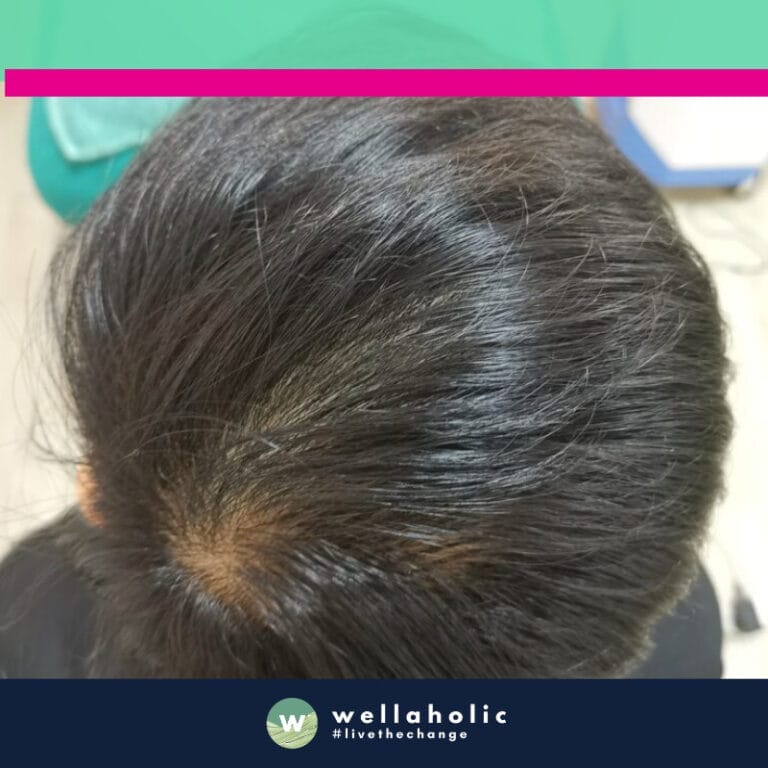

Customer Testimonial for Benefits of Scalp Microneedling
Vijay Ganesh sought treatment at Wellaholic for hair loss and thinning hair, choosing the Scalp RF Microneedling procedure. He was particularly impressed with his therapist, Khanie, who he described as experienced and hospitable, contributing to a wonderful microneedling session. Vijay was able to see results after several sessions of scalp microneedling treatments over the period of two to three months.
Read Actual Review by Customer
The therapist khanie is an experienced and hospitable person who did a wonderful job during the microneedling session. I recommend her if you are taking the treatment. (Source: Google Review)

Conclusion
Traction alopecia is a preventable form of hair loss caused by repeatedly pulling on the hair through tight hairstyles or accessories. While it can affect anyone, it’s most common among women of African descent who frequently wear tight braids, weaves, or extensions.
We’ve seen that early detection and intervention are crucial for reversing traction alopecia. By recognizing the signs – such as a receding hairline, scalp irritation, or thinning hair along the temples – and promptly changing hair care practices, most people can stop and even reverse the hair loss. However, if left untreated for too long, the damage to hair follicles can become permanent.
The good news is that traction alopecia is entirely preventable. By opting for looser hairstyles, avoiding chemical treatments, and giving your hair and scalp regular breaks from tight styling, you can maintain healthy hair growth. For those already experiencing symptoms, treatments like minoxidil and anti-inflammatory medications may help stimulate regrowth when combined with gentler hair care routines.
At Wellaholic, we’re committed to helping our customers achieve healthy, beautiful hair. If you’re concerned about hair loss or traction alopecia, we invite you to try our HairGrow 3X treatment. This comprehensive approach combines Scalp RF Microneedling, Minoxidil Scalp Booster, and Low Level Laser Therapy to promote hair regrowth and scalp health. Don’t let traction alopecia hold you back – take the first step towards fuller, healthier hair today.
Frequently Asked Questions (FAQ)
FAQ 1: What is Traction Alopecia and How Does It Happen?
Traction alopecia occurs when prolonged tension or pulling on the hair follicles damages them, leading to hair loss. This condition is common among individuals who frequently wear tight hairstyles like ponytails, braids, or extensions. In Singapore’s humid climate, scalp health can be further compromised by sweat and irritation. Wellaholic addresses this issue with tailored treatments that focus on strengthening hair roots and reducing inflammation. Our expertise ensures clients regain confidence through personalized solutions.
🔵 Tight hairstyles such as braids and buns exert constant pressure on hair follicles.
🔵 Humidity in Singapore exacerbates scalp irritation, worsening traction alopecia symptoms.
🔵 Early detection of thinning areas allows for more effective treatment outcomes.
🔵 Customized therapies at Wellaholic promote healthier hair regrowth over time.
🔵 Education about safer styling practices helps prevent future occurrences.
FAQ 2: Can Traction Alopecia Be Reversed, and What Are the Treatment Options?
Yes, traction alopecia can often be reversed if addressed early. Treatments typically involve minimizing stress on the scalp while promoting healing of damaged follicles. At Wellaholic, we offer advanced therapies like low-level laser therapy (LLLT) and nutrient-rich scalp infusions designed to stimulate dormant follicles. By combining these methods with expert advice, we empower our clients to restore their natural hair density effectively.
🔵 LLLT stimulates blood flow to the scalp, aiding in follicle repair.
🔵 Nutrient-infused treatments nourish weakened roots with essential vitamins.
🔵 Avoiding harsh chemicals and heat styling supports recovery efforts.
🔵 Regular follow-ups ensure progress tracking and adjustments to care plans.
🔵 Personalized recommendations cater to individual hair needs.
FAQ 3: How Can I Prevent Traction Alopecia Before It Starts?
Preventing traction alopecia involves adopting gentle hair care habits and avoiding excessive strain on your scalp. Wellaholic emphasizes education around safe styling techniques and products suited for fragile hair types. As experts in hair wellness, we guide clients toward protective measures that preserve both style and scalp health. With proper prevention strategies, you can maintain vibrant, healthy locks even in challenging environments like Singapore’s tropical weather.
🔵 Opt for looser hairstyles to reduce tension on hair follicles.
🔵 Use soft accessories like silk scrunchies instead of elastic bands.
🔵 Limit use of heavy extensions or weaves that pull on the scalp.
🔵 Incorporate hydrating shampoos and conditioners into your routine.
🔵 Schedule regular check-ins with professionals for proactive care.
FAQ 4: Why Is Scalp Health Important for Treating Traction Alopecia?
A healthy scalp serves as the foundation for strong, resilient hair growth. When affected by traction alopecia, an inflamed or irritated scalp hinders follicle recovery. Wellaholic prioritizes scalp rejuvenation through specialized treatments targeting underlying issues like dryness, dandruff, or sebum imbalance. By restoring optimal scalp conditions, we create an environment conducive to long-term hair restoration and overall wellness.
🔵 A clean, balanced scalp reduces the risk of infections or further damage.
🔵 Improved circulation enhances nutrient delivery to hair follicles.
🔵 Addressing inflammation promotes faster healing of stressed areas.
🔵 Regular exfoliation removes buildup that clogs pores.
🔵 Professional-grade products maintain moisture without greasiness.
FAQ 5: What Role Does Nutrition Play in Managing Traction Alopecia?
Nutrition plays a vital role in combating traction alopecia, as deficiencies in key nutrients like biotin, iron, and zinc can weaken hair structure. In collaboration with dietary experts, Wellaholic provides holistic guidance to complement external treatments. Clients learn how to fortify their diets with foods rich in antioxidants and proteins, ensuring internal support for visible improvements in hair quality and resilience.
🔵 Biotin-rich foods like eggs and nuts strengthen keratin production.
🔵 Iron boosts oxygen supply to hair follicles, preventing breakage.
🔵 Omega-3 fatty acids from fish improve scalp hydration and elasticity.
🔵 Zinc regulates oil glands, keeping the scalp balanced.
🔵 Antioxidant-packed fruits combat oxidative stress linked to hair loss.
FAQ 6: How Does Wellaholic Stand Out in Treating Traction Alopecia?
Wellaholic distinguishes itself through its comprehensive approach to treating traction alopecia, blending cutting-edge technology with personalized service. Our team combines years of experience with innovative treatments tailored to each client’s unique needs. Whether it’s addressing early signs of thinning or reversing advanced damage, our goal is to deliver lasting results backed by science and compassion. Trust us to help you achieve a fuller, healthier head of hair.
🔵 Advanced diagnostic tools identify root causes accurately.
🔵 Tailored treatment plans adapt to individual progress and goals.
🔵 Highly trained staff provide ongoing support throughout recovery.
🔵 State-of-the-art equipment ensures safe and effective procedures.
🔵 Client satisfaction remains central to every interaction.

Serene Chiam, Aesthetic Director (LinkedIn)
Serene Chiam, the Aesthetic Director at Wellaholic in Singapore, is a highly experienced and knowledgeable professional in the field of hair regrowth and aesthetics. With over a decade of expertise, including her previous role as a Clinical Aesthetics Manager with Laser Clinics Australia, Serene brings a wealth of knowledge and practical experience to her clients. Her CIDESCO certificate in skin care and Bachelor of Health Science (Aesthetics) from Torrens University of Australia further demonstrate her commitment to providing the highest quality hair regrowth treatments and aesthetic services.
Contact Serene at [email protected]
GET IN TOUCH
Book Now Pay Later

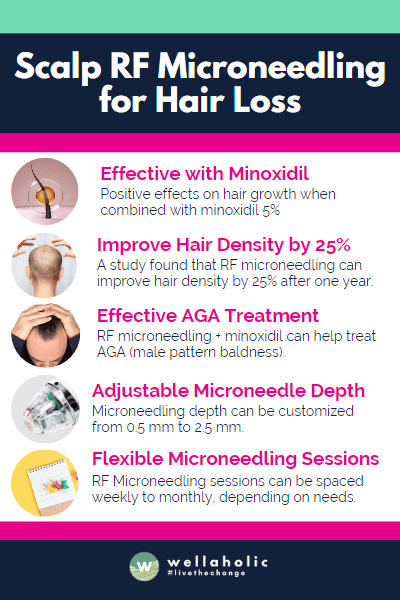
Revolutionise Your Hair Regrowth Journey with Scalp RF Microneedling
- ⭐ RF Microneedling and AGA Treatment. RF microneedling + minoxidil can help treat AGA (male pattern baldness).
- ⭐ Efficacy in Pattern Hair Loss. RF microneedling is effective for hair loss in both men and women.
- ⭐ Study Results on Hair Density Increase. A study found that RF microneedling can improve hair density by 25% after one year.
- ⭐ Adjustable Depth of Microneedling. Microneedling depth can be customized from 0.5 mm to 2.5 mm.
- ⭐ Flexible RF Microneedling Frequency. RF Microneedling sessions can be spaced from weekly to monthly, depending on your needs.
- ⭐ Award-Winning. Wellaholic’s treatments have been recognized by top beauty publications such as Daily Vanity, Beauty Insider, and Tropika Club Magazine.
- ⭐ Over 2000 Verified Customer Reviews. Wellaholic has over 30 industry awards and over 2000 positive reviews from customers, and >50% are repeat customers.
